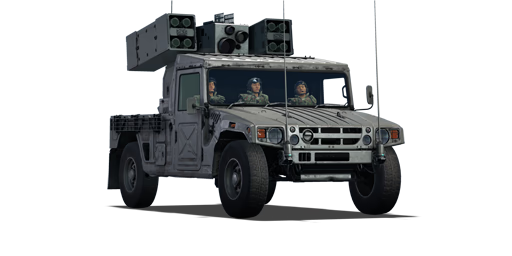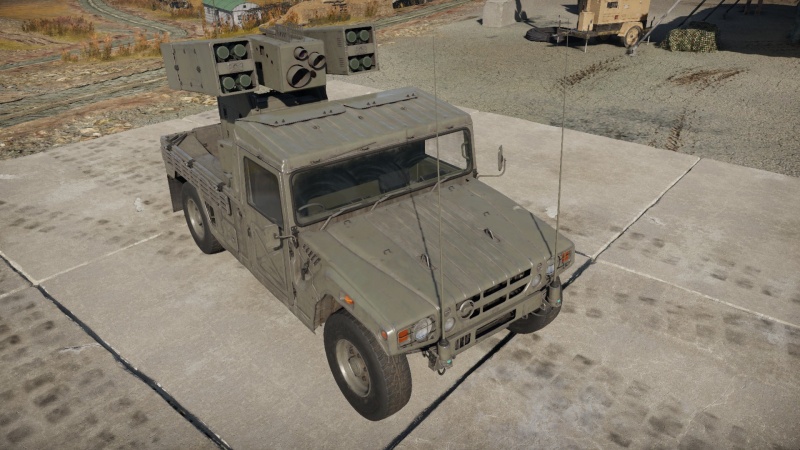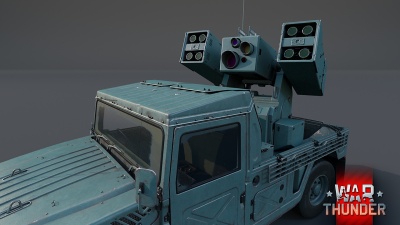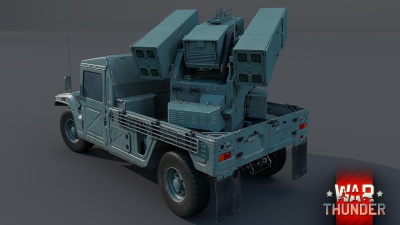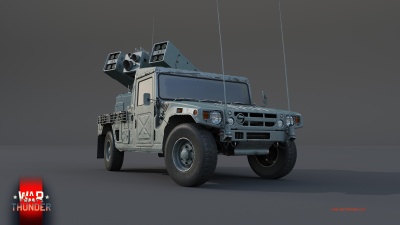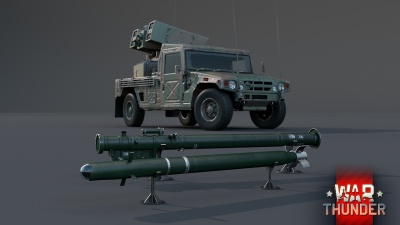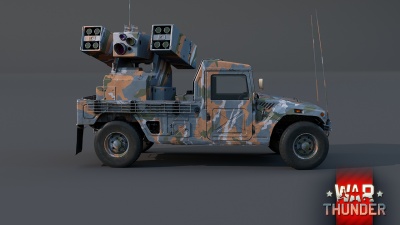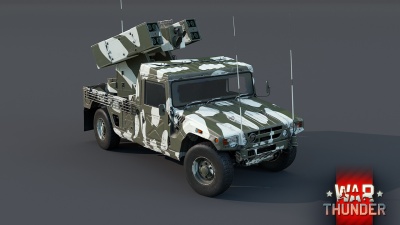Difference between revisions of "Type 93"
m (Grammar issue in first "Con" and bullet point period consistency) (Tag: Visual edit) |
(→Ammunition: Updated) |
||
| Line 87: | Line 87: | ||
! 0% !! 50% !! 100% | ! 0% !! 50% !! 100% | ||
|- | |- | ||
| − | | Type 91 || SAM || 1,000 || 4,500 (all-aspect) || | + | | Type 91 || SAM || 1,000 || 4,500 (all-aspect)<br>7,000 (rear aspect) || 11.5 || 1 || 10 || 648 || 47° || 56° || 65° |
|- | |- | ||
|} | |} | ||
| Line 105: | Line 105: | ||
* Missiles empty from left missile box to right | * Missiles empty from left missile box to right | ||
* Further emptying of the missiles are shown by an arrow | * Further emptying of the missiles are shown by an arrow | ||
| − | |||
== Usage in battles == | == Usage in battles == | ||
Revision as of 12:05, 17 April 2021
Contents
Description
The Type 93 is a rank VII Japanese SPAA with a battle rating of 9.3 (AB/RB/SB). It was introduced in Update "Starfighters".
General info
Survivability and armour
Armour protection on this vehicle is near non-existent, but the idea of "no armour is best armour" holds up true here. The armour is only suitable for stopping small arms fire as the vehicle is designed to be hidden away from the front lines. The hull armour is 5 mm thick all around, slightly more armour is offered on the wheels, chassis and the turret at around 10 mm. However there is a lot of empty space in this vehicle that means you can get lucky and avoid an otherwise critical hit.
This lack of armour allows this vehicle to obtain some of the fastest speeds in game on flat roads and a more than adequate speed off-road.
| Armour | Front (Slope angle) | Sides | Rear | Roof |
|---|---|---|---|---|
| Hull | 5 mm | 5 mm Top 5 mm Bottom |
5 mm | 5 mm |
| Turret | 10 mm Turret front 10 mm Gun mantlet |
10 mm | 10 mm | 10 mm |
Mobility
| Game Mode | Max Speed (km/h) | Weight (tons) | Engine power (horsepower) | Power-to-weight ratio (hp/ton) | |||
|---|---|---|---|---|---|---|---|
| Forward | Reverse | Stock | Upgraded | Stock | Upgraded | ||
| Arcade | 136 | 39 | 4.2 | 232 | 324 | 55.24 | 77.14 |
| Realistic | 125 | 36 | 133 | 170 | 31.67 | 40.48 | |
Modifications and economy
Armaments
Main armament
| Type 91 missile (x8) | Turret rotation speed (°/s) | Reloading rate (seconds) | ||||||||||||
|---|---|---|---|---|---|---|---|---|---|---|---|---|---|---|
| Mode | Capacity (Belt) | Fire rate | Vertical | Horizontal | Stabilizer | Stock | Upgraded | Full | Expert | Aced | Stock | Full | Expert | Aced |
| Arcade | 8 (8) | 60 | 0°/+70° | ±180° | Two-plane | 88.1 | __._ | __._ | __._ | __._ | 19.50 | 17.25 | 15.90 | 15.00 |
| Realistic | 59.5 | __._ | 85.0 | __._ | __._ | |||||||||
The main armament for the Type 93 is a SAM launcher built by Toshiba Heavy Industries, loaded with Type 91 missiles. These missiles are a variant of the Type 91 SAM-2 fired from handheld launchers by infantry. Their design and purpose are similar to the AIM-92 Stinger.
The launcher features a centralised optic system and 2 x 4 launchers located on either side. The turret is capable of 360 degree turning and elevation of 70 degrees, but there is no depression on the launcher meaning firing at targets below you will be difficult.
The missiles use an infrared and image-guidance system. It can lock onto heat-emitting targets but is also smart enough to detect the target through countermeasures, thus nullifying common countermeasures such as flares. The optics contain a TV camera, infrared sensors, laser receivers and IFF antennas. These feed through to a launch control device located on the passenger side of the vehicle.
This optic also allows you to track onto targets within ±1 degree of the sight, however offers no radar itself to spot incoming enemies so they must be manually spotted and locked.
The launcher has a warm up time of 4s before it can gain a lock and fire the missiles. It is advised to keep the missiles warmed at all times to intercept fast-moving jets. Only 1 missile can be fired per target and warm up and lock on must be achieved again.
The launcher can be fired on the move unlike other SPAA.
Ammunition
| Shell details | ||||||||||
|---|---|---|---|---|---|---|---|---|---|---|
| Ammunition | Type of warhead |
Velocity (m/s) |
Range (m) |
Projectile Mass (kg) |
Fuse delay (m) |
Fuse sensitivity (mm) |
Explosive Mass (TNT equivalent) (g) |
Ricochet | ||
| 0% | 50% | 100% | ||||||||
| Type 91 | SAM | 1,000 | 4,500 (all-aspect) 7,000 (rear aspect) |
11.5 | 1 | 10 | 648 | 47° | 56° | 65° |
Ammo racks
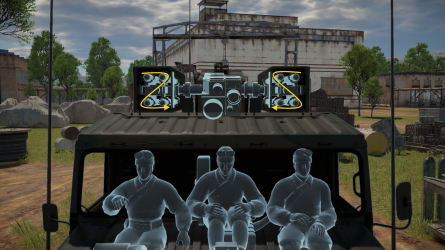
| Full ammo |
1st rack empty |
Visual discrepancy |
|---|---|---|
| 1 | 0 (+ 1) | Yes |
- Missiles empty from left missile box to right
- Further emptying of the missiles are shown by an arrow
Usage in battles
One of the main advantages of this vehicle is the speed, your main goal will be not on the front lines but behind offering support or flanking to intercept air targets. With a range of 7 km in rear aspect and 4.5 km in all aspect you will need to move closer to the enemy than would be ideal for a vehicle like this. This vehicle is ideal for taking wide flanks through less trafficked parts of the map to get into position to lay ambushes for enemy air. While waiting for enemy air targets to spawn, you can also scout ground targets for your team.
On some maps you can be key to getting a quick cap on a middle point, or decapping a less contested point giving your team a slight advantage. Using your speed you can get in and out before many tanks realise you were even there.
In SB this vehicle really shines as maps are larger to allow more flanking so you can set up ambushes easier. Though the downside is as this vehicle does not feature radar you will have to rely on sounds and team callouts to know where to aim. However this is offset by the fact your missile lock on does not set off early warning unless you activate tracking, and by the time enemies see you it will be too late to avoid.
Pros and cons
Pros:
- Very high top speed for a ground vehicle.
- Its armament of SAMs can be deadly, especially at long range.
- Lock on does not set off early warning for Jets or Helicopters.
- Missiles can be fired on the move.
- Fire and forget - after you successfully locked and launched missile, you can retreat without having to lead the target, unlike other SPAA.
Cons:
- Missiles have a tendency to miss targets.
- Can easily be destroyed by heavy machine guns and strafing aircraft.
- As with nearly all light vehicles, it is susceptible to the "Hull Break" mechanic.
- No gun armament for backup
- As with all "cars", this vehicle cannot pivot in place like tanks can.
- Warm up time of 4s on the launcher and missiles.
- Hard collisions at fast speeds can instantly destroy the vehicle.
- Tendency to oversteer at high speeds due to high hp/ton ratio.
History
The Type 93 Short Range SAM (93式近距離地対空誘導弾) was a direct successor to the L-90 35 mm Anti-Aircraft Twin Cannons found on vehicles such as the Type 87 or as a separate towed emplacement.
Within the Ministry of Defense the vehicle is known as the SAM-3. The military shortened it as Short-SAM (近SAM) or nicknamed it as the Closed Arrow (クローズドアロー).
- Development
The first prototypes of the Type 93 were built in 1990 with the first tests already taking place in 1992. The main reason for having a short development time was because the missile itself, the Type 91 or SAM-2 (a man portable SAM launcher), was already done with its development in 1991 and was to simply be fitted on a Toyota Mega Cruiser. Most of the development time was put into the Fire Control System.
In 1993 it was adopted within the JGSDF as the Type 93 Short Range SAM and deployment started from 1994.
It is a vast improvement over the 35 mm KDA with the ability to track and shoot down enemy aircraft with its infrared homing included in the system. The Type 93 utilises 3rd generation infrared and ultraviolet guidance systems, which allow it to record a target's image profile and ignore defensive countermeasures such as flares.
A total of 113 SAM systems were made, the last being produced in 2008.
As of 5 October 2020, the Ministry of Defense has announced they would replace the Type 93 by the fiscal year (FY) 2021 with "an improved version of the SAM currently used for air defence by the JASDF".
Devblog
Development on the Type 93 mobile SAM platform began in 1990 after the Japanese Department of Defense tasked the Toshiba Heavy Industries company with modifying the already in service military version of the Toyota Mega Cruiser (designated BXD10) to carry the Type 91 surface-to-air missiles with the aim of creating a contemporary replacement for conventional gun-armed SPAA units.
Given how all necessary components were already more or less readily available, the actual development time for the new vehicle was fairly short. As a result, shortly after the order was issued in 1990, a prototype of the Type 93 was built and underwent successful testing. In 1993, the vehicle was officially accepted into service with the JGSDF and mass production commenced. In total, 113 Type 93s were built between 1993 - 2008, with all produced units serving exclusively with the JGSDF even until this day.
Media
- Skins
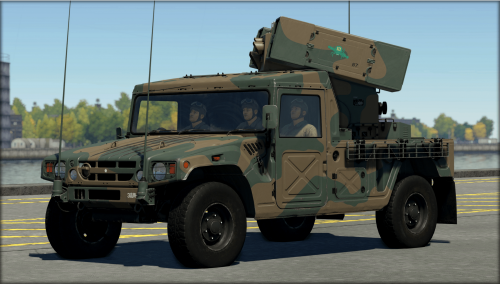
- Devblog Images
- Videos
See also
Links to the articles on the War Thunder Wiki that you think will be useful for the reader, for example:
- reference to the series of the vehicles;
- links to approximate analogues of other nations and research trees.
External links
- [Devblog] Type 93: Breaking Barriers and Airframes
- [Forum] Type 93 Close Range Surface to Air Missile (SAM-3)
| Japan anti-aircraft vehicles | |
|---|---|
| Ke-Ni Derivatives | Ta-Se · So-Ki |
| Wheeled | Type 94 |
| Tracked | SUB-I-II |
| Radar SPAAG | Type 87 |
| Missile SPAA | Type 93 · Type 81 (C) |
| USA | ▅M16 MGMC · ▅M19A1 · ▅M42 |


